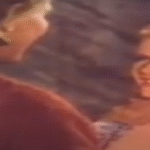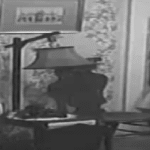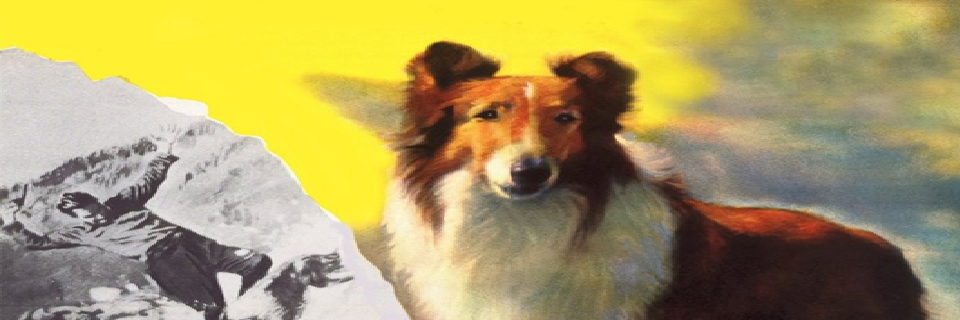The Painted Hills, released in 1951, is a Western drama that combines the rugged charm of frontier life with a heartfelt tale of loyalty, justice and retribution. Notably, it features the famous collie, Lassie, in a rare non-contemporary role, taking on the part of a faithful dog who becomes the moral centre of a story involving betrayal and gold fever in the American wilderness. The film may be modest in scale, but it delivers emotional resonance through its setting, its characters and its simple yet effective storytelling.
The plot follows Jonathan Harvey, a seasoned prospector who has spent years mining in the remote hills with his trusted dog, Shep. Jonathan is portrayed as a kind-hearted, hard-working man who dreams not just of striking it rich, but of building a better life for those he cares about. He shares a strong bond with Shep, whose loyalty and intelligence are evident from the outset. After years of searching, Jonathan finally hits a rich vein of gold and decides it is time to settle down.
Rather than hoard his newfound wealth, Jonathan travels to the nearby town to share his fortune with the family of his late partner, who died before seeing any reward for his toil. He finds Martha Blake, the widow, and her young son, Tommy. Martha now lives with her new partner, Lin Taylor, a man who appears respectable but soon reveals more self-serving motives. Jonathan offers to split his gold claim with Lin, trusting him as the man looking after his old friend’s family. Lin, however, is consumed by greed and begins to covet the entire claim for himself.
When Jonathan returns to the claim with Lin, intending to begin preparations for a proper settlement and mining operation, Lin’s darker nature begins to surface. He resents the idea of sharing the gold and grows increasingly hostile. During a confrontation in the hills, Lin murders Jonathan in cold blood, hiding the body and returning to town with a fabricated story about Jonathan having gone missing. Only Shep, ever faithful, knows what truly happened, and from this point forward, the dog becomes the unlikely hero of the tale.
Shep returns alone, wounded and distraught, to the town. His behaviour alerts young Tommy, who senses something is terribly wrong. However, few adults take the dog’s strange conduct seriously, and Lin, now assuming control of the claim, begins to manipulate the situation to his advantage. He uses his charm and authority to maintain a façade of innocence, even as his greed begins to erode the relationships around him.
Meanwhile, Shep’s actions grow more determined. He refuses to accept Jonathan’s death in silence, showing up repeatedly where he is not wanted, interfering with Lin’s work, and drawing the attention of Tommy and eventually others. The bond between boy and dog strengthens as Tommy begins to follow Shep’s clues, slowly piecing together what really happened in the hills.
The film shifts between human drama and the dog’s tireless efforts to expose the truth. In one tense sequence, Shep leads Tommy back to the mountains, risking injury and danger to guide him to the site of Jonathan’s murder. This loyalty is not just touching, but serves as the moral heartbeat of the film. Shep is not driven by vengeance but by fidelity and a desire for justice, standing in stark contrast to Lin’s greed and cowardice.
As the story unfolds, Lin’s paranoia deepens. He begins to see Shep as a threat and attempts to eliminate the dog. In several harrowing scenes, Shep narrowly escapes traps and attacks, proving not only his intelligence but his unbreakable spirit. The wilderness setting reinforces the sense of isolation, danger and the thin line between civilisation and lawlessness. Lin’s villainy becomes more desperate and erratic, making it clear he is a man trapped by his own lies.
Eventually, the tension comes to a head when Shep, despite being injured, manages to lead the townspeople to the hidden grave where Jonathan’s body lies. The evidence is undeniable, and Lin’s guilt is exposed. In a final confrontation, Lin attempts to flee, but justice, both human and poetic, catches up with him. He meets a fitting end, undone by the very wilderness he tried to conquer for his own gain.
In the aftermath, Tommy and Martha are left to grieve Jonathan’s loss, but they find solace in Shep’s presence. The film closes on a note of reflection, with the painted hills serving as a backdrop to the enduring themes of loyalty, sacrifice and the triumph of good over evil. Lassie, as Shep, delivers a performance that transcends the novelty of an animal role, expressing a wide range of emotion and intent that grounds the film in genuine pathos.
Visually, The Painted Hills makes the most of its Technicolor palette, with the landscape playing a vital role in setting the tone. The natural beauty of the hills is both majestic and foreboding, representing opportunity and peril in equal measure. The contrast between the warm, sunlit plains and the shadowed, rugged hills mirrors the emotional journey of the characters, particularly the divide between Jonathan’s honest intentions and Lin’s deceitful schemes.
Musically, the score complements the mood with a mix of sweeping melodies and tense, dramatic cues. The sound design is simple, yet effective, especially in scenes where Shep navigates the wilderness or confronts danger. There is an air of classic Western drama throughout, but tempered by the sentimental lens through which the story is told.
What makes The Painted Hills stand out is its use of a dog as the central figure of justice. While many Westerns of the time focused on shootouts and rugged heroes, this film takes a gentler, more emotional approach, allowing the audience to connect with the idea of loyalty through the actions of a non-human character. It explores the idea that justice is not only a human concept, but something tied to deeper instincts of love, protection and honour.
Despite its simplicity and modest runtime, the film delivers a compelling story about the corrupting influence of greed and the enduring strength of loyalty. It is a tale as old as the hills themselves, brought to life with sincerity and heart. The Painted Hills may not have the grandeur of larger Westerns, but it offers a touching and memorable experience, reminding us that even in the harshest environments, loyalty and love can survive, and sometimes it takes a dog to remind people of what truly matters.







